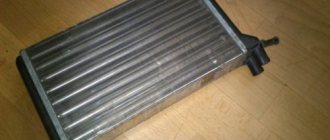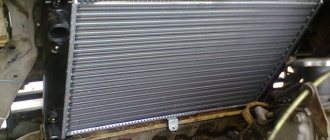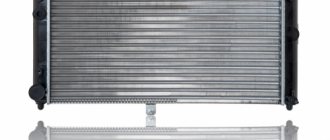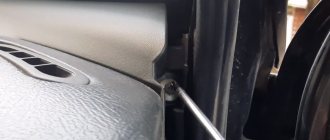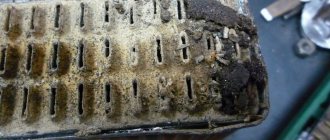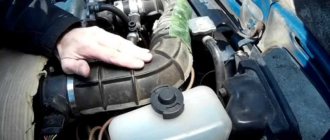The radiator is one of the main components in the car engine cooling system, which is installed in the front part of the body to intake cold air and cool the liquid circulating inside the pipelines. The system constantly operates under high mechanical and temperature loads, which leads to rapid wear and damage.
Very often, it is the cooling radiator that suffers first: small plastic and aluminum segments of the unit crack, through which coolant begins to leak. This is an unpleasant malfunction that is difficult to deal with on the road. However, the radiator needs urgent repairs!
The radiator is leaking: what to do, how to find the leak and how to fix it
The cooling radiator is the main element of the engine cooling system.
The operation of a cooling radiator is the active transfer of heat into the atmosphere from the heated coolant. This process is important for efficient engine operation, because The coolant, before giving off heat in the radiator, takes this heat from the heated components and parts of the engine. This was originally intended by the designers, but life makes its own adjustments to the operation of the car on the road. A situation when the arrow on the dashboard begins to treacherously creep up, and, unfortunately, this arrow is not an indicator of the fuel level, but an indicator of the coolant temperature, modestly indicating that the car is starting to overheat. Steam is pouring out from under the hood, and a liquid stain of coolant is slowly but surely spreading on the asphalt. The radiator is leaking, what should I do?
Causes of radiator leaks in the car cooling system
Before you do anything, you need to figure out what led to this result. This may be external damage as a result of stones, or the plastic elements of the radiator may crack as a result of an impact in a minor accident. Such minor damage, as a rule, cannot be immediately identified, and problems arise from them over time. In the meantime, the driver continues to operate the car, gradually, drop by drop, losing coolant from the system.
What is the danger of antifreeze leaking from a car cooling system?
As the coolant level drops, the risk of engine overheating increases, which in turn can lead to the following problems:
Deformation of the plane of the cylinder block or cylinder head
Cylinder head gasket deformation
· Changes in the configuration of the cooling system and associated failure of system components
All of the above cases will lead to expensive repairs.
What to do if the cooling radiator is leaking
The first rule in this case is to monitor the coolant level.
In fact, periodically checking the vehicle's technical fluids before a trip is a good rule; this will help to promptly notice an emerging problem and eliminate it. Even if the cooling radiator leak is small, do not underestimate the scale of the current situation. Over time, radiator leakage will increase, and this point can be overlooked. The driver will not like the result.
Therefore, if such a situation occurs, it is necessary to have a supply of coolant or distilled water. Yes, if the loss of coolant is small, then for the first time you can use distilled water, but you need to take into account that the more distilled water gets into the system, the more we increase the freezing point of the coolant. Therefore, if it’s winter outside, you shouldn’t get carried away with distilled water, but add coolant.
What to do in case of major damage and leakage of the cooling system
If there is serious damage to the engine cooling system, repairs are inevitable; operating the vehicle in this case is extremely undesirable. And in order not to end up with engine repairs, you should move the car to a technical center using a tow truck, or, in extreme cases, on a cable.
How to seal plastic parts of a cooling system with a leak
If the design of the radiator allows, then you can use a heat-resistant sealant-adhesive, better known as cold welding. In some cases, you will need to remove the radiator from the car.
Cold welding is a special two-component sealant that may contain metal shavings. Such sealants allow you to quickly restore plastic or metal parts.
The gluing process itself is not complicated:
· Before applying the sealant, the surface must be prepared, cleaned and degreased.
· Prepare the sealant for use by mixing the two components. The components must be thoroughly mixed to obtain a homogeneous mass.
· The sealant is applied to the part.
The composition will set in 3-5 minutes, but until complete hardening it will take from an hour to a day, depending on the composition.
Is it possible to solder aluminum radiators and how to do it correctly
If a radiator leak occurs on an aluminum part, then sealing is possible.
The process is complicated, and we would recommend entrusting it to professionals, because... If the attempt fails, you will have to redo everything again. · You will need a powerful soldering iron and it must be warmed up well before work.
· The walls of the radiator will also need to be thoroughly heated.
· Clean the surface thoroughly before soldering.
· To ensure good soldering quality, it is necessary to use solder with a high tin content.
This method will require removing the radiator from the car, which means that when installing the radiator back after repair, it is advisable to completely replace the coolant.
Repairing antifreeze leaks in the cooling system using a special sealant
There is another way to eliminate a radiator leak that does not require partial or complete disassembly of the system. This is a sealant that works inside the cooling system. For example, Liqui Moly - Kuhler-Dichter cooling system sealant. This product seals small leaks in the radiator, metal porosity in solder areas, and hairline cracks. Seals damage that is quite difficult to localize (determined only by a drop in the coolant level). You can use the product with all types of additives in the cooling system and any antifreeze. Suitable for all cooling and heating systems.
Contains water-soluble monomer and plastic chips suspended in a monoethylene glycol solution. When there is a pressure difference and when oxygen is available, the polymerization reaction is activated and the polymerization products seal the coolant leaks.
Application of the sealant is very simple:
· Shake the can before use.
· Add sealant to the cooling system at the rate of 250 ml. additives for 10 l. coolant.
· Let the engine idle or drive the vehicle for at least 10 minutes.
The sealant can remain in the cooling system for the entire service life of the coolant.
To avoid major repairs, you should regularly check the cooling system for the slightest malfunctions and leaks, change hoses and pipes in a timely manner, and monitor the temperature of the antifreeze during operation. Also, do not forget to change the coolant in a timely manner, as over time it loses its properties, which can lead to malfunctions in the operation of the entire system.
Is repair always possible?
It is not always advisable to repair a radiator. In some cases it will be easier and even cheaper to install a new one. But how do you understand that this is exactly the situation before you and not waste time on recovery? We'll help you figure it out.
- Leaks that are located at the junction of the radiator with the plastic pipe cannot be repaired. You can fix the leak, but only for a temporary effect. It is better to use epoxy glue or sealant.
- Nothing can save you from corrosion, which caused the system to depressurize. It is not worth spending any time, money or materials on such a radiator. It must be recycled.
- Structural damage resulting from an accident often cannot be repaired. Even if there is a chance of success, the repair costs will be considerable.
Any leak starts with a small crack, which will be much easier and faster to fix. With timely repairs, the radiator can serve for a long time and properly cope with its duties. Remember, not all defects can be eliminated; in some, especially advanced cases, you will have to replace the part.
The best prices and conditions for the purchase of new cars
Cooling system design
The car's cooling system consists of:
- radiator;
- water pump;
- expansion tank;
- pipes and hoses;
- thermostat.
A radiator is a grille of pipes and plates made of light metal: aluminum, brass or copper. Numerous tubes reduce the cooling volume, and plates increase the heat exchanger area.
The heat exchanger for a car cooling system is made of aluminum, copper or brass
All components are connected to each other by pipes and hoses. The water pump (pump) drives coolant through one of the circuits. The thermostat is responsible for circulating the refrigerant in a long or small circle. From a physics textbook we know that a liquid increases in volume when heated. The expansion tank helps compensate for this physical property of antifreeze.
Installation of a new radiator in a Lada Priora with air conditioning
Replacing the heater radiator in a Priora car with air conditioning is a fairly simple process. The latter unit appeared only in newer cars, in particular, Priors began to be equipped with a HALLA or Panasonic climate control system. Thanks to the new component, you can replace any part of a non-working stove only by dismantling the frill, getting rid of the windshield wipers, the stove itself or the vacuum brake booster.
If a motorist wants to understand how to remove the heater radiator on a Priora with air conditioning, he must start by removing the sound insulation located in the engine panel. After this, you should dismantle the power unit air filter hose and remove the seal, which is located near the radiator hoses. Then you should drain the coolant and lift the radiator up towards the mechanic.
The danger of constant antifreeze leakage
The most popular dangers that arise from antifreeze leaks from the radiator include engine overheating, created by the inability of the cooling system to efficiently remove engine heat. You need to know that excessive heating of the cylinder head can quickly damage its shape and the integrity of the gasket, and if you ignore the temperature indicator signals and continue to drive the car, the engine can jam, and everything will end in an expensive overhaul.
A fluid leak from the radiator can lead to unpleasant consequences for both the car and the driver. This is due to the creation of high pressure in the cooling system while the engine is running. The temperature of antifreeze or antifreeze in the system is quite high and dangerous for humans. If the driver opens the hood to find out the cause of the engine overheating, then even a small crack in the radiator housing can significantly increase and form a hot geyser with boiling coolant. If it comes into contact with the human body, it leads to a thermal burn, after which urgent medical attention is required.
Advantages of cold welding
To eliminate a leak, it is enough to cut off (break off) a piece of sealant, thoroughly knead it in your hands until it acquires the state and appearance of a homogeneous mass, and then spread it directly onto the damaged area of the VAZ radiator. You can use the car within 15 minutes after drying, and the glue completely hardens a day after the repair.
The main advantages of the glue in question are its following features:
- “Cold welding” has the same coefficient of expansion as metal, which avoids complex repairs after repairing a leak using the substance in question.
- The service life of a patch made from “cold welding”, when applied correctly, can reach several years.
Fluorescent additives will help quickly and effectively identify the location of a leak. They mix with any antifreeze, coloring it. The driver can only inspect the connection points of the pipes (leaks most often occur here) and promptly eliminate the identified malfunction in order to get to the repair site without any problems. When going on a long journey behind the wheel of your own car, it is extremely important to have some kind of sealant with you.
Price and article
The table below shows several good manufacturers, the price of their products and the article number by which you can find and purchase this part.
| Manufacturer | vendor code | Price, (rubles) |
| DAAZ | 21082-1301012 | 2300 |
| Luzar | 21082-1301012U | 1655 |
| PRAMO | 21082-1301012 | 1310 |
| Hofer | HF708412 | 1300 |
Model selection
For the VAZ 2110 you can choose either aluminum or copper radiators. To a large extent, the choice depends on what result you need: saving money or durability and reliability.
Their disadvantages and advantages:
- Aluminum. Lightweight, relatively cheap, the price depends on the manufacturer: - Luzar (2110-8101060) - about 1000 rubles; - Pramo (2110-1301012) - retail approximately 1600 rubles. But its thermal conductivity interferes, and it cools the engine worse. In addition, it is subject to fairly rapid corrosion; it takes less time for it to flow;
Aluminum radiator cooling
Copper cooling radiator with 40% increased efficiency
Coolant replacement
First of all, you need to drain the old antifreeze through the drain hole in the radiator. In this case, it is necessary to protect the generator from liquid ingress. You can speed up the draining process by removing the lid from the tank.
Attention! If the drained antifreeze is green, then it cannot be used because it has lost its cooling properties.
- Remove the heating pipe for the throttle body.
- Fill the liquid slightly above the level indicated on the reservoir.
- Press the nozzle to pump out the air.
Thus, detecting a leak in a VAZ-2114 is quite simple. You just need to carefully inspect the cooling system. And fixing a leak will not be a problem for an experienced car owner.
The interior of the car was disassembled after an antifreeze spill, and at the same time noisy, since the factory heat and sound insulation had become unusable
Before finding the reasons for the smell of antifreeze in the cabin, you need to understand the design of the cooling system.
So, let's look at how the engine coolant system works:
Scheme and design of the cooling system
1 – expansion tank plug; 2 – expansion tank; 3 – coolant drain hose from the throttle pipe; 4 – hose from the radiator to the expansion tank; 5 – radiator outlet hose; 6 – left radiator tank; 7 – aluminum radiator tubes; 8 – plug; 9 – right radiator tank; 10 – drain plug; 11 – radiator core; 12 – electric fan casing; 13 – electric fan impeller; 14 – electric motor; 15 – pump gear pulley; 16 – pump impeller; 17 – camshaft drive toothed belt; 18 – engine block; 19 – pump supply tube; 20 – radiator supply hose; 21 – heater radiator outlet hose; 22 – coolant supply hose to the throttle pipe; 23 – exhaust pipe; 24 – filling hose; 25 – heater radiator supply hose; 26 – thermostat; 27 – coolant temperature sensor; 28 – coolant level indicator sensor
Reasons for the appearance of antifreeze under the rugs and on the bottom of the VAZ-2114
It’s good if the weather is warm outside, it will dry quickly. If it's frosty outside, you'll have to heat it up.
So, when the issue of the design of the cooling system has been considered, we can proceed directly to considering the reasons for the appearance of the smell of antifreeze in the car interior:
- Problems with the cooling system pipes.
- The heater radiator is faulty.
- The interior floor is filled with antifreeze.
- Smell from a new heater radiator.
- The smell is coming from the engine compartment.
The main reasons have been identified, and now we can proceed directly to considering methods for eliminating the effect.
Elimination methods
There are several reasons for the smell of antifreeze in a car. Of course, to eliminate this you will need some tools, as well as knowledge of the design of the VAZ-2114 cooling system, which was discussed above.
Stove faucet
In the process of replacing the stove valve
One of the most common reasons. In this case, the antifreeze will be mainly under the driver's mat. The faucet can only flow in certain modes, for example, in heat. Therefore, when diagnosing the heater valve, try turning on different heater modes.
Problems with the cooling system pipes
Leaking coolant system pipes
The most common reason for the smell of antifreeze in the car interior is that cracks appear in the heater pipes, which cause coolant to leak onto the radiator. When heated, this element causes antifreeze to evaporate in the cabin, which actually causes this effect.
The elimination method, in this case, is simple - inspect the inlet and outlet pipes of the stove, and if cracks are found, they must be replaced. Diagnostic operations must be carried out hot, with the interior heating system running.
Heater radiator is faulty
Faulty heater radiator
The heater radiator repeatedly causes the smell of antifreeze to appear in the cabin, which flows out of it and evaporates. In this case, it is necessary to disassemble the heating system and diagnose the stove radiator. If cracks or defects are found on it, the part must be replaced with a new one.
The interior floor is filled with antifreeze
Smudges are visible on the upholstery, but traces of antifreeze are more clearly visible on the mat itself
Many motorists have encountered antifreeze found under the floor mats, which evaporates during the heating of the interior, and also in an inert state soaks into the floor covering and causes an unpleasant odor.
The elimination method is quite simple - dry cleaning the interior . Also, it is worth understanding how the antifreeze got onto the floor of the car. This can be caused by leaks from the radiator and heater pipes during the period when the car is used without a heater and the outside temperature is not too low to turn on the heater.
Smell from new heater radiator
After replacing the old heater core, the smell of antifreeze may appear in the cabin. This may be due to two reasons. Firstly, loose connections between the pipes and the radiator . To diagnose and fix it, it is necessary to check whether the clamps connecting the pipes and the heater radiator are tightly tightened.
Replacing the radiator of a heating unit in a Priora that is not equipped with air conditioning
Replacing the heater radiator on a Priora without air conditioning may make sense if warm air has stopped flowing into the cabin, while the heater itself is working. If, in addition to the above problem, there is also a water leak from under the Priora stove, the motorist will have to remove the poorly functioning unit in order to solder the latter. Sometimes repairs are impractical and you have to replace the old device with a new one.
So, first of all, you need to start by removing the negative terminal from the battery. The fact is that the issue here is not only about the safety of the master himself, but also about additional insurance, which allows him to avoid several unpleasant surprises that, if handled carelessly, can arise not only with wiring, but also with electrical equipment.
If you are replacing the heater radiator on a Priora without air conditioning, after de-energizing the system, you can begin to dismantle the windshield trim. At the same time, the wiper levers, which can cause future discomfort during operation, should also be removed. After this, you should rid the unit of all plastic tubes through which the liquid located in the windshield washer reservoir goes directly to the nozzles. Only after all the above steps have been completed will it be possible to remove the decorative trim located along the edges of the windshield. In fact, it’s easy to carry out such a manipulation - just get rid of seven self-tapping screws.
Replacing the heater radiator on a Priora can only be done after removing the hood seal. Before dismantling, it should be noted that in the middle of the lining there is a screw that tightens both halves of the structure. Using a screwdriver or any knife, you can gently lift the plugs (this element serves as the “cover” of the screw) and unscrew them.
After this, you can begin to remove the sound insulation, which is located in the power unit compartment. To do everything correctly, you will have to unscrew the screws and remove the pads (there is no clear rule about which of them to remove first: left or right). Then you should get rid of the pipes that go directly to the radiator. A person who wants to understand how to get to the heater radiator on a Priora must loosen the clamps holding the structure itself.
After this, you can remove all the wires going directly to the stove from the connectors. You can remove them using two keys, in particular, one “10” and the other “8”. After unscrewing all four nuts, move the wiring harness to the side, which is held by the holder. The “13” key will help to dismantle the bracket located on the brake pedal. Only after this can you begin to remove the heater radiator on a Priora that does not have air conditioning. A regular Phillips screwdriver will help you dismantle the device, allowing you to remove 3 screws. All the rest of the work consists of installing a new unit and reassembling the system in the reverse order of the described actions.
In fact, there is another way to replace the system element of interest. To open free access to this element, dismantling not the stove body, but the vacuum brake booster will help. It is worth noting that this procedure will only be successful if the brake pedal is removed along with it. Such actions help to get closer directly to the left side of the stove and the desired device.
What is a heater radiator?
The heater radiator belongs to the cooling system. It looks like a mini version of the main engine cooling radiator and is essentially a small unit that consists of small tubes installed in parallel, connected by a series of cross plates (or fins) designed to dissipate heat. This radiator ensures the operation of the interior heater and the vehicle's glass heating system.
Causes of leaks
There are not many of them and they are all conditionally divided into several groups, which are worth considering in more detail:
- Natural wear and tear. First of all, this refers to corrosion processes that, over time, destroy thin radiator tubes and form leaks. But sometimes the cause of failure of the structural elements of the radiator can be small scratches, dents, chips, which turn into corrosion spots.
- Mechanical damage. They usually occur after a head-on collision. Even a small defect in the bumper or decorative grille can be enough to cause the radiator to leak. The second point is sloppy installation work, during which the honeycombs of the product and its tubes were carelessly damaged.
- Loosening of fastenings. It can happen over time due to vibrations or during repairs, when an inexperienced car enthusiast simply forgets to properly tighten one or another clamp on the pipe.
- Wear or defect of the expansion tank (radiator) cap. In this case, the pressure created in the CO will push the antifreeze through the bad cap. This can be determined by the traces of coolant around the filler neck.
DIAGRAM AND DEVICE OF THE COOLING SYSTEM
The cooling system of the VAZ 2114 is liquid, with forced circulation. Antifreeze or antifreeze is poured into the system as a coolant. In the most extreme case, you can fill it with water, but you can’t drive it for a long time - in winter you can defrost the engine, and during the rest of the season, when the engine is used for a long time on water, the cooling jacket in the block and cylinder head is corroded, and rust accumulates in the radiator.
The VAZ 2114 engine cooling system (SOD) consists of the following elements:
- Radiator. It is the main cooling part in the system and performs the function of transferring heat to the liquid into the surrounding airspace;
- Water pump (pump). The pump creates forced movement of antifreeze in the system, thereby cooling the entire SOD, including the internal combustion engine (ICE). The pump rotates from the timing belt;
- Branch pipes (hoses). Antifreeze circulates through them;
- Thermostat. It regulates the passage of coolant through all pipes or only in a small circle and maintains the required operating temperature of the internal combustion engine;
- Electric fan. The fan is located on the plane of the radiator and, due to the air flow created, cools its surface when turned on. The electric motor turns on only when the temperature set by the sensor is reached (103°C);
- Expansion tank. Liquid is poured into the tank, and when the fan is activated, antifreeze flows into it through the return hose, thereby releasing excess pressure into the SOD;
- Expansion tank plugs. There are valves in the plug that relieve excess air pressure created in the system when antifreeze circulates.
The VAZ 2114 cooling diagram is shown in the figure below:
Cooling diagram for VAZ-2114
The design of the engine cooling system on the VAZ model 2114 is simple and practically no different from the design of any other fuel-injected internal combustion engine of a passenger car. After starting the engine, the water pump is driven by the rotating crankshaft through the timing belt. The pump creates coolant circulation in the system, and the antifreeze passes through a small circle (pump, upper pipe, cylinder block). When the internal combustion engine is heated to operating temperature, the thermostat valve opens and the coolant flows through the lower pipe into the internal combustion engine in a large circle.
RADIATOR
The VAZ radiator is aluminum, consists of a double-row core and two plastic tanks on the sides. Coolant is poured into it through the expansion tank; there is a drain plug at the bottom.
PIPE
The set of cooling system pipes includes:
- Upper and lower pipes (main);
- Metal tube of water pump;
- Filler hose from the expansion tank to the radiator;
- Return hose from tank to radiator;
- Two hoses for heating the throttle valve.
Check the integrity of the pipes (very often they sell defective ones in car dealerships)
Test of modern sealants
To increase the tightness of the cooling system and eliminate leaks in the radiator, special sealants are offered to car owners. They are also called “Stop-flow”.
The attitude towards sealants is ambivalent. Same as for engine oil additives and fuel tank tablets. The opinion of car manufacturers is negative. In car maintenance books, in the section devoted to the engine cooling system, there is not a word about “Stop-leak” additives. Their answer to a leak is to replace the radiator with a new one.
But what to do if the antifreeze level drops sharply on the road and the destination is still quite far away? There is an exit. Stores and gas stations sell additives that can help fix leaks. This is an emergency method that allows you to get to the nearest service station without any problems. Sealants cannot permanently cure a radiator from leaking. The main problem with additives is the formation of excess deposits in the car’s cooling system.
Stop-leak additives are an emergency method for eliminating radiator leaks. The sealant helps you get to the nearest service center and repair the heat exchanger
To make the choice easier, a summary table with two characteristics will help: the time of clogging of holes of different diameters and the level of deposits. To evaluate the last parameter, we used the mass of the thermostat before and after applying the additive. Such testing of sealants was carried out at the Department of Internal Combustion Engines of St. Petersburg Polytechnic University.
Fines for crossing the stop line and speeding will no longer bother you!
Sealant
BBF SuperLiqui MolyK-SealHi-GearGunkFillinTime of plugging of calibration holes, s0.3 mm203075351541260.5 mm8562115962246120.7 mm124883153452452921.0 mm146118380630218—Change in thermostat mass, gDifference+1,454+1,324+0,965+1,970+2,798+1,735The table shows that sealants cope with microcracks successfully, even large holes are blocked within 2-10 minutes.
Examples of products in the photo
Signs of a malfunction of the cooling system.
Most often, failure of the cooling system is associated with loss of tightness, which leads to coolant leakage. The symptoms of this problem are easy to spot:
- reducing the level of antifreeze in the expansion tank below the minimum,
- a sharp increase in the temperature indicator readings on the instrument panel,
- copious steam of boiling liquid from under the hood,
- antifreeze drips on the engine protection or under the front of the car when parked.
Causes of antifreeze leaks.
A coolant leak occurs when one or more components of the cooling system fail:
Cylinder block.
The liquid coolant circulates in the engine block through a system of special channels - the cooling jacket. If a malfunction occurs, antifreeze may leak for the following reasons:
- insufficient tightening of the cylinder head bolts,
- head gasket failure,
- formation of metal microcracks.
If, after a long period of parking on a cold engine, coolant leaks are noticeable at the junction of the head and block, then most likely the cylinder head bolts are not tightened properly.
To eliminate a leak, check the tightness of the bolts and, if necessary, tighten them to the required torque. If the cylinder head gasket is damaged, the antifreeze goes inside the engine: either into the combustion chamber or into the crankcase.
Coolant entering the combustion chamber causes unstable engine operation (up to the impossibility of starting) and thick milky-white smoke from the muffler. Antifreeze that gets into the combustion chamber washes away all the carbon deposits until they shine, which can be determined by turning out the spark plugs and shining a flashlight into the spark plug wells. It is also possible that exhaust gases under pressure enter the cooling jacket and form vapor locks in it. In this case, in a well-warmed-up car at high speeds, there is a sharp increase in the amount of antifreeze in the expansion tank, until the expansion cap is knocked out.
If the coolant goes into the engine crankcase, it mixes with the oil. This fact can be diagnosed by the presence of a white emulsion coating on the oil filler cap and on the oil dipstick. A sharp darkening of fresh antifreeze is another symptom that the cooling system is in contact with oil. It is necessary to replace a broken or burnt cylinder head gasket.
The worst option is the appearance of microcracks: the symptoms are similar to the previous case, but it is problematic to eliminate this problem with your own hands. First of all, the crack may not be visible on the removed part, but it will certainly manifest itself when the bolts are tightened and on a warm engine. To eliminate microcracks, the head or block is polished using specialized equipment. In the worst case scenario, you will need to purchase a new cylinder head.
Heater dampers don't work
The distribution of air flows throughout the cabin is carried out by dampers, which, in turn, are controlled using cables. When these cables fail, problems arise with directing the air flow to the windshield or to the foot area. In addition, the damper that blocks the flow of air from the street begins to work incorrectly. In this case, adjustment of the damper drives is required.
Such situations can arise even on a new car. Slightly warm air begins to flow from the lower, upper and side deflectors, and hot air begins to flow from the center console. This is due to the poor build quality. There are gaps between the joints of the air ducts and the dampers, which leads to warm air entering only from the center console and heating the panel from the inside.
The drive cable is always taut. Therefore, over time it bends, breaks off or stretches. In this case, it is necessary to adjust the damper drive, which is performed in the following order:
- In the stove, we look for a bracket with which the cable sheath is held on the heater body.
- A galvanized metal lever located on the left side is pulled back. This position corresponds to the maximum opening of the damper.
- The length of the cable is tightened and adjusted. The long lever on the lever block in the extreme right position should open the damper completely.
- After adjustment, the cable is securely fixed.
Video: stove repair using the example of a VAZ 2114
FakeHeader
Comments 14
Plug, change the plug. And fill it with high-quality antifreeze or antifreeze
Since there is no way to change the plugs, I temporarily sealed it with black Abro sealant. It seems that after this the antifreeze remains level in the tank. When I get to the mechanic, I will definitely ask the plugs to be changed. Thanks everyone for the answers.
The plug has run, it needs to be repressed, it’s better to give this work to good mechanics, don’t try it yourself, you’ll be tortured either to knock it out or drive it in.
Check the supply pipe to the pump.
you need to see that it is a crack. If yes, install a sealed cover
when you turn it off you will drive it in, heat the block with a gas burner a little then it will go in easily, I tried it when it was cold to no avail! I changed it without removing the engine for 2 hours, unscrew the exhaust manifold, lift the face of the car, drop it down, just unhook the resonator from the rubber bands, and use a screwdriver to punch a hole in the plug and carefully pry it with something, it will pop out. It’s inconvenient, but it’s all fucked up, they held my legs upside down and I hammered in the plug)))
“All the antifreeze leaked out in a couple of minutes”: the pump leaked on the road. How did you get home?
An incident happened to me the other day that made me cheer up and step away from the daily routine. The incident happened 4 days ago, in the evening, I won’t say the exact time, but I remember that it was around 22:00.
As I drove from the center towards home, thoughts arose in my head:
However, after a couple of minutes such thoughts disappeared. Something seemed wrong with the car, so I decided to stop. On the street I smelled a slight smell of antifreeze.
I was unpleasantly surprised after opening the hood - coolant was flying in different directions.
I immediately realized that the pump was leaking. I closed the hood and looked under the car - there was a puddle, although the car had been standing for 10-20 seconds. I jumped behind the wheel and rushed home, simultaneously looking at the engine temperature gauge.
What is typical is that until this moment the pump gave no cause for concern, did not leak or make any noise, but then it suddenly burst.
I tried to drive at low and medium speeds so that the pump rotated as little as possible. I didn’t have time to get home; the temperature rose sharply. I didn’t drive for long, but in those couple of minutes all the antifreeze leaked out.
I turned off the car while driving; I didn’t want to deal with the consequences of overheating. I left it by the road.
The next morning I came with 5 liters of water, poured it into the engine and drove to the house, there were 500 meters left to go. I arrived and immediately drained the water.
What followed was the process of repairs, monetary and time investments. In total, I did it for about a day and a half, and then waited for the sealant to dry. The gasket that came with the pump was leaking, so I removed it and applied high-temperature sealant.
After removing the old pump, I was surprised that I didn’t notice how noisy it was.
I replaced the pump, the timing belt tensioner pulley, as well as the alternator belt, installed the timing belt, and turned the ignition on.
I started it - everything is fine. Only for some unknown reason the free play of the throttle cable has decreased, if anyone knows why this happened, write in the comments.
Comrades, have you ever had any interesting incidents on the road? Write them briefly in the comments, perhaps with your permission, I will write about each case according to the material.
There is still a lot of useful and interesting things about cars ahead!
Source
The smell of antifreeze in the cabin
It seems like the interior smells like antifreeze. I looked under the rug, it seemed a little wet, but I didn’t understand the water (I recently washed it) or antifreeze (it was dark, I left this examination for the morning). I also think the windows are fogging up a little.
2. Is it possible to drive like this?
Maybe the radiator is on the stove? On the 08 it comes out so quickly, on the ten I don’t know, but I think so too.
Damn, it looks like a new one, most likely the clamps on the radiator on the stove have loosened, you need to buy German ones, expensive ones, replace them and everything will be fine.
Car: VAZ-2110. Asks: Dmitry Aksyonov. The essence of the question: the car began to smell like antifreeze, what should I do?
This morning I smelled a strange smell. I thought for a long time what it was, then I realized that it smelled like antifreeze. What should I do? There is already a strong smell in the cabin, help. Is this hazardous to health?


